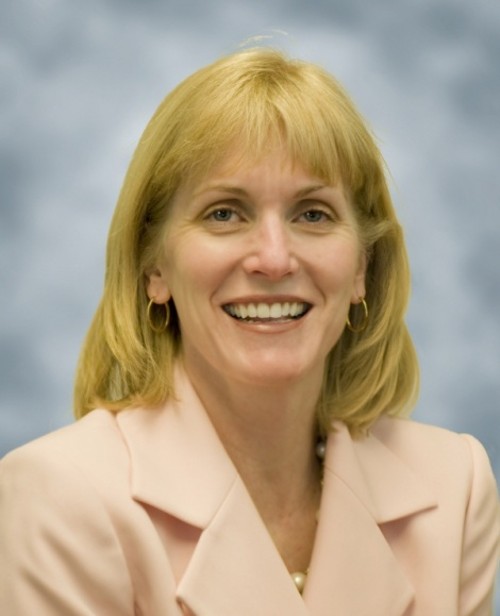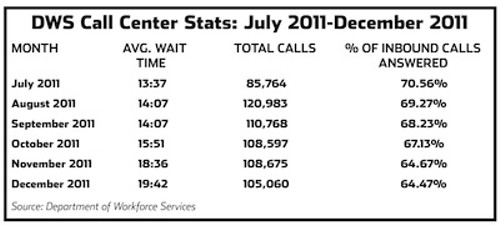Kristen Cox, executive director of the Department of Workforce Services, has a problem with federal assistance. In a recent blog titled “Work Is a Good Thing,” Cox chides Medicaid for being “void of any work or job-search requirements or the expectation that people who are in a position to work actually do.” The United States, she argues, “could begin to refine the meaning of ‘entitlement’ and provide individuals with the dignity and pride that comes through employment.”
Cox, a conservative Republican, hides neither her ideological views nor her priorities, having named employers as her No. 1 focus in 2009. DWS also works with job seekers and handles public-assistance programs.
Since Cox was named director in 2007, she’s restructured eligibility processing, resulting in savings of $22.6 million, and reduced staff by 23 percent, writes DWS communications director Joseph Demma in an e-mail.
Astoundingly, the cuts were achieved in the face of a recession-fueled tripling of the number of Utahns seeking public assistance—183,600 cases are projected for 2012. That, along with the fact that a management consultancy profited from the cost cutting, has low-income advocates calling foul.
The cost reductions, though driven in part by new technology, were guided by Viable Vision, an out-of-state management consultancy brought in on a bonus scheme. The size of the company’s bonus was dependent on the amount of savings achieved by cutting DWS costs.
In late December 2011, Cox posted on her Facebook page that during Gov. Gary Herbert’s presentation of his 2013 budget recommendations, he’d “singled out” her administration “as being a great example of optimization and streamlining of government services.”
But low-income advocates argue such a severe cut in costs and staff has negatively impacted low-income services, with, for example, a West Valley-based centralized call center seeing increasing phone wait times and more dropped calls.
“The ultimate thing that is troubling about all this is, she’s acting like her goal is trying to increase the profitability of a sales division rather than running programs that help low-income families,” says the Crossroads Urban Center’s Bill Tibbitts. “Modernization doesn’t have to be a bad thing. You just have to have some basic minimum standards for customer service.”
Cox’s critics are not relegated to outsiders. Internal disquiet for those changes was apparent Feb. 9, 2012, at a legislative subcommittee meeting, when Rep. Jim Bird, R-West Jordan, chair of the Workforce Services and Economic Development Standing Committee, read excerpts from a letter by a former DWS employee, one of several who had complained to Bird, albeit the first to put her name to it.
The writer, whom Bird did not name, cited high turnover, employees working overtime without pay, being told they had to be 90 percent “perfect” in their accuracy, and being threatened by managers that if they questioned supervisors, they’d “be written up.”
Bird says he was “extremely surprised” by allegations of a management culture of fear. Nevertheless, he adds, he still views Cox as “an incredible individual.”
That’s an assessment that’s hard to disagree with, given all Cox’s achievements. Cox, who lost her sight to a degenerative disease when she was a child growing up in Sandy, attended Brigham Young University and went on an 18-month mission to Brazil. A seven-year resident in Maryland, she was that state’s first disabilities secretary.
In 2007, she moved back to Utah with her family when then-Utah Gov. Jon Huntsman Jr. appointed her head of the 2,000-strong DWS, with a $1.6 billion annual budget, most of which is federally funded programs.
She wasn’t the only one in her family to find rewards in the Beehive State. Cox’s husband, Randy Cox, an IT specialist, was hired in 2007 by the Department of Community and Culture (DCC) to supervise the digitization of its documents. As DCC’s IT project manager, Cox was officially employed by Science Applications International Corporation (SAIC), a Fortune 500 company with an IT contract with the state of Utah dating back to 2004.
Demma notes that Kristen Cox arrived in the midst of a “perfect storm of a downturn economy that affects this agency in unique ways. We faced budget reductions, and we were seeing spikes in our caseload. The challenge was how to balance that effort and provide a top-notch quality service to our customers and be accountable for all the dollars spent.”
Due to scheduling difficulties related to the 2012 Legislative session, Cox was unavailable for an interview with City Weekly, according to a DWS spokesman.
In September 2010, DWS sought a management consultancy that specialized in the Theory of Constraint, an approach to streamlining manufacturing that’s also applied to the public sector. DWS hired Illinois- and Connecticut-based management consultancy Viable Vision via a subcontract linked to SAIC’s IT contract with the state of Utah. This was the same contractor that had employed Randy Cox to handle projects at the DCC and several other Utah departments.
Viable Vision helped DWS achieve “savings in real operating expenses to the state,” says Viable partner Kevin Fox, which ultimately meant staff reductions. The consultancy was on a $300,000 flat-salary-plus-a-bonus scheme. The more it saved DWS, the more it earned. Viable Vision also trained staff in removing “constraints” that Fox says slowed down eligibility determination.
In early April 2011, with Viable hard at work, Cox pledged to cut 142 full-time employee positions and save $9.2 million. After Viable Vision ended its contract in November 2011, Demma says the consultancy had achieved around $6 million in savings. According to the bonus schedule laid out in a contract City Weekly obtained through a records request from the purchasing arm of the Department of Technology Services, $6 million in savings should have triggered a $75,000 bonus for the consultancy. However, Demma says, Viable’s bonus was $354,000, of which $50,000 was travel expenses. That was the maximum bonus allowed by the contract.
The 23 percent staff reductions were achieved through “attrition” of employees retiring or moving on, Demma says.
Fox concurs. “Kristen didn’t put anybody through the ringer of losing their job,” he says. But low-income advocates say that not only did DWS staffers have to reapply for their positions, but that senior employees were also passed over in favor of younger, less experienced workers. Demma says that after two DWS divisions were restructured, “there were less supervisor and managerial positions available, and several staff did have to compete for the new positions.” Advocates argue that in the face of such tactics, it was unsurprising that Cox actually exceeded her goal, with, to date, around 160 staff members leaving.
In late 2011, the DWS administration issued what Demma calls “a goal” to cut the Temporary Assistance for Needy Families (TANF) caseload by 10 percent, or 18,000 cases. That’s to support Gov. Herbert’s “100,000 jobs in 1,000 days” initiative, he adds.
Salt Lake Community Action Program advocate Karen Silver isn’t surprised at the move, pointing out that in recent years, DWS has cut back on the due process afforded families who face losing TANF benefits for noncompliance, seemingly making it more difficult and time-consuming for families to regain benefits or rejoin the TANF program.
Cox’s dramatic leadership has earned her not only a total compensation package of $187,000, but also won her agency awards and plaudits. Governing magazine cited Utah as “the poster child” for the constraints theory. The February 2012 article noted that among DWS’s successes was a reduction in phone wait times from 23 minutes to 9 minutes. But at a recent meeting with DWS officials, low-income advocates heard a different story. Average wait times at the DWS’s call center between July and December 2011 had actually climbed from 9 minutes to almost 20 minutes. Advocates claim anecdotal evidence of 45-minute waits. The percentage of calls answered for the same period dropped from 71 percent to 64 percent.
Silver says DWS, judging by those figures, is not efficient. “I don’t know any private business that would succeed with that number of unanswered calls.”
Despite such doubts, DWS is poised to absorb the $230 million annual budget of Housing and Community Development (HCD), currently part of the DCC. That’s thanks to House Bill 139, sponsored by Rep. Wayne Harper, R-West Jordan. He is proposing that the housing arm be pulled out of the DCC and added to the 90 federal and state programs Cox currently oversees.
While housing advocates question both the motivation and the logic for Cox’s agency to take over HCD, HB139 seems part of a larger design. In a working paper on the proposed merger, obtained through a records request by Crossroads Urban Center, there is commentary on how an HCD/DWS merger could lead to an “economic prosperity model” that would not only “slow and then turn the cost curve on assistance programs,” but also reshape local government’s efforts to alleviate poverty.
“The interesting thing about all this is the persistent faith that more data about why people are poor will magically improve their lives,” Tibbitts says.
Though Cox’s star continues to rise in Utah’s political firmament, advocates now aren’t the only ones asking questions.
Despite Bird’s admiration for Cox, he was sufficiently troubled by employee complaints to request a DWS audit. “If there’s an issue, where’s the problem?” he says. “If we have the means to correct it, we will.”
More by Stephen Dark
-
Call it a Comeback
Long mired in economic depression, Midvale’s Main Street dusts off its small-town charm.
- Sep 20, 2017
-
Love Letters
Correspondence between a young woman at the Topaz internment camp and her beloved sheds light on Trump's America.
- Sep 6, 2017
-
Triggered
Veterans Affairs exists to help vets. So why did the Salt Lake VA appoint an anti-veteran chief?
- Aug 30, 2017
- More »
Latest in News
Readers also liked…
-
Raise a glass for E.L.T Harrison, architect of the Beerhive building on Main
Small Lake City
- Oct 11, 2023






